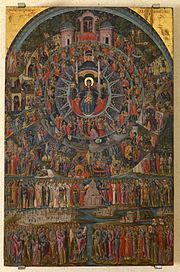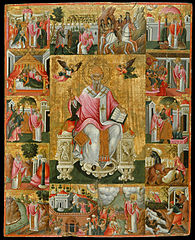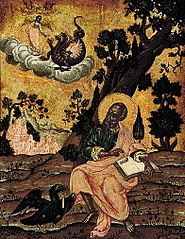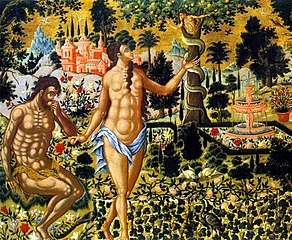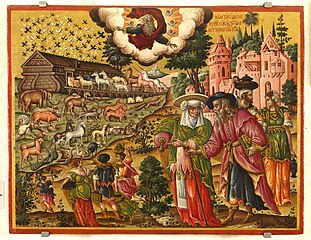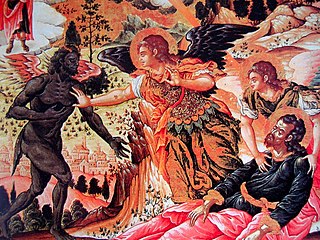art.wikisort.org - Artist
Theodore Poulakis (Greek: Θεόδωρος Πουλάκης; 1622–1692) was a Greek Renaissance painter and teacher. He is considered the father of the Heptanese School and one of the most prolific painters of Venetian Crete. Poulakis was a member of the Cretan School, his contemporary was Emmanuel Tzanes. Emmanuel Tzanes and Poulakis were active painters of the Cretan School until Candia, went to war with the Ottomans around 1649. Candia finally fell after twenty years of siege in 1669. Poulakis settled on the island of Corfu. Stephanos Tzangarolas was another famous painter in Corfu around the same period. Poulakis's works are likened to Andreas Pavias and Georgios Klontzas. Poulakis works exhibit qualities of the Venetian school. Over 130 of his paintings have survived and can be found all over the world.[1][2][3]
Theodore Poulakis | |
|---|---|
 Hymn to the Virgin | |
| Born | 1622 Chania, Republic of Venice |
| Died | 1692 (aged 69–70) Corfu, Greece |
| Nationality | Greek |
| Known for | Iconography and hagiography |
Notable work | St. John the Baptist, St. Spyridon and scenes from his life, The Nativity of Christ |
| Movement | Cretan School, Heptanese School |
History
Poulakis was born in Chania Crete. He was the son of Antonios. He was married and had two children Vittirous and Eleni. By the age of twenty-four, he was living in Venice. He stayed there for thirteen years until 1657. His son was baptized in Venice in 1646 and his daughter two years later. He was a member of the Quaranta council. Famous Greek painters Philotheos Skoufos, Emmanuel Tzanes, Konstantinos Tzanes, and Ioannis Moskos were all living in Venice around that time. Poulakis was a member of the Greek Brotherhood of Venice in 1654.[4]
In 1657, Poulakis migrated to Corfu. He signed a six-year contract to teach painting to Marinos Damistras son Tzorzi. According to the contract, Tzorzi had to follow Poulakis anywhere he went including Venice. Philotheos Skoufos was a witness for Poulakis in a legal matter around 1666. Poulakis traveled to Cephalonia where he painted. By 1671, he was back in Venice one year later he was voted a member of the Quaranta e Gionta. In 1673, he took part in a baptism. By 1675, he was back in Corfu where he lived out the remainder of his life. He died on November 16, 1692.[5]
Painting style
Some of his paintings escaped the traditional maniera greca and exhibit fuller shapes and variations of color. His work Hymn to the Virgin followed the Greek tradition and is comparable to Andreas Pavias Crucifixion of Jesus. Clearly, both artists try to fill the canvas with figures. Both of the paintings follow the traditional Greek style. Another painting by Greek painter Georgios Klontzas, All Creation Rejoices in Thee closely resembles Hymn to the Virgin where the virgin is at the Center of the icon and countless figures occupy the iconic space. Georgios Klontzas clearly inspired the work of Poulakis.[6][7]
He is one the fathers of the Heptanese School due to his transition from painting styles. He does not always observe the traditional lines and shapes of maniera greca. His paintings Adam and Eve, Noah's Ark, and the Birth of Isaac are examples of the transitional period of the Cretan School to the more refined sophisticated art of the Heptanese School. Clearly, Michael Damaskinos experimented with this transition in his The Last Supper, and The Wedding of Cana.[8]
Theodore Poulakis takes his viewers from the Cretan School to the Heptanese School but Michael Damaskinos began playing with the idea one hundred years before Poulakis. El Greco never successfully converted the Cretan School to his stylistic transitions. Poulakis continued painting until the time of his death.[9]
Gallery
Cretan School
- In Thee Rejoiceth
- Virgin, Tree of Jesse
- St. John the Baptist
- Saint Nicholas
- St.Spyridon and scenes from his life
- Palaiokastritsa monastery, Corfu Icon of the St. George
- Saint John
- The Ascension of Prophet Elijah and Scenes from his life.
Heptanese School
- Archangel Michael
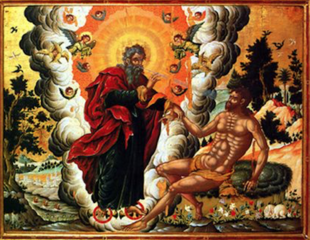 God Creates Adam
God Creates Adam God Creates Eve
God Creates Eve- Adam and Eve
- Noah's Ark
- Birth of Isaac
- The Nativity of Christ
- Death of Moses
Notable works
- In Thee Rejoiceth (Poulakis)
- Adoration of Joseph, Collection Sterbini Rome, Italy
- The Four Knights of the Apocalypse Collection by S. Amberg Switzerland
- Onuphrius Entrhoned Livorno, Italy
- John the Baptist as Child Sotheby's London, United Kingdom
- John the Theologian Lefkosia, Cyprus
- Crucifixion, Collection of Abou-Adal Beirut, Lebanon
- All Thee Rejoices Private Collection Spain
- Noah's Ark (Poulakis)
- The Archangel Michael (Poulakis)
- The Fall of Man (Poulakis)
- The Miracle of the Holy Belt
See also
- Greek scholars in the Renaissance
- Ioannis Apakas
- Konstantinos Kontarinis
- Ioannis Tzen
References
- Bigham, Steven (2000). Heroes of the Icon: People, Places, Events. New York NY: Oakwood publications. p. 136.
- Hatzidakis, Manolis & Drakopoulou, Eugenia (1997). Greek painters after the fall (1450-1830) Volume B. Center for Modern Greek Studies E.I.E. pp. 304–317.
- Eugenia Drakopoulou (February 10, 2022). "Poulakis (Pulachi, Pulaki) Theodoros (Theodoro, Thodoro)". Institute for Neohellenic Research. Retrieved February 10, 2022.
- Hatzidakis, 1997, pp 304-317
- Hatzidakis, 1997, pp 304-317
- Vikan, Gary (1988). Icon. Baltimore, Md.: Trust for Museum Exhibitions, Walters Art Gallery. p. 59.
- Hatzidakis, 1997, pp 304-317
- Hatzidakis, 1997, pp 304-317
- Hatzidakis, 1997, pp 304-317
Bibliography
- Hatzidakis, Manolis (1987). Greek painters after the fall (1450-1830) Volume A. Center for Modern Greek Studies E.I.E.
- Hatzidakis, Manolis & Drakopoulou, Eugenia (1997). Greek painters after the fall (1450-1830) Volume B. Center for Modern Greek Studies E.I.E.
- Drakopoulou, Eugenia (2010). Greek painters after the fall (1450-1830) Volume C. Center for Modern Greek Studies E.I.E.
На других языках
- [en] Theodore Poulakis
[es] Theodore Poulakis
Theodore Poulakis ( en griego, Θεόδωρος Πουλάκης ; 1622-1692) fue un pintor y maestro del Renacimiento griego. Se le considera el padre de la Escuela Heptana y uno de los pintores más prolíficos de la Creta veneciana. Poulakis fue miembro de la Escuela Cretense, su contemporáneo fue Emmanuel Tzanes. Emmanuel Tzanes y Poulakis fueron pintores activos de la Escuela Cretense hasta que Candia, entró en guerra con los otomanos alrededor de 1649. Candia cayó finalmente, tras veinte años de asedio, en 1669. Poulakis se estableció en la isla de Corfú. Stephanos Tzangarolas fue otro pintor famoso en Corfú en la misma época. Las obras de Poulakis se comparan con las de Andreas Pavias y Georgios Klontzas. Las obras de Poulakis presentan cualidades de la escuela veneciana. Se conservan más de 130 cuadros suyos, que se pueden encontrar en todo el mundo.[1] [2] [3][fr] Théodore Poulakis
Theodore Poulakis (grec moderne : Θεόδωρος Πουλάκης, 1622–1692) est un peintre d'icônes grec de la Renaissance. Il est né en Crète et s'installa à Venise où il réalisa la plus grande partie de son œuvre. Il est un des artistes de l'école crétoise d'icônes et contemporain d'un autre crétois le peintre d'icône Emmanuel Tzanes qui vécut longtemps à Venise également[1]Другой контент может иметь иную лицензию. Перед использованием материалов сайта WikiSort.org внимательно изучите правила лицензирования конкретных элементов наполнения сайта.
WikiSort.org - проект по пересортировке и дополнению контента Википедии
